Lyla
Lyla, 3 Royal Terrace, Edinburgh EH7 5AB
Tel: +44 (0) 131 285 8808
Internet: lylaedinburgh.co.uk
GPS: 55.956850, -3.180842
The Menu:
Alp blossom cheese, onion, quince
Bluefin tuna, nori, koshu
Lobster, kohlrabi, sake
Cured halibut, kelp, Umai caviar
Langoustine, burnt apple
Chawanmushi, North Sea crab, white kombu
Laminated brioche, ampersand/koji butter, wild garlic butter
Squid, tomato, lemon verbena
Hand-dived scallop, N25 caviar, Sauce Choron
Wagyu, maitake, truffle
Laganory, hibiscus, lavosh
Amalfi lemon, yoghurt, bronze fennel
Strawberry, crème crue, rose
Petits fours (bon bon, financier, canelé, pâte de fruit)
The Wine:
Pertois-Lebrun Champagne L’Extravertie Blanc de Blancs Extra Brut NV
Domaine de la Taille aux Loups Montlouis-sur-Loire Clos de Mosny 2019
The presentation of a dish is the art that whispers to the eyes, or so I have been told. Well, the plates which come from Stuart Ralston’s flagship kitchen at Lyla do a lot more than whisper. Lyla’s ten-course tasting menu undoubtedly conveys an artistic quality, but it does much more than whisper sweet nothings. This is food which speaks with great clarity, telling us of the talent of the chef and his team.
Stuart Ralston has already made one or two appearances on these pages; years ago, before I even knew his name, my palate was swept off its feet by the vanguard of novel ingredients and literally dancing dishes which confronted me at Aizle, the first of his Edinburgh restaurants to open its doors. Success followed, and Aizle subsequently moved to smarter (and larger) premises at the west end of the city, where it did a roaring trade for many years. As local foodies will already know Aizle has since closed down, Stuart choosing to refocus on his other venues, including Noto, a restaurant serving deliciously down-to-earth small plates. The bulk of his attention, however, is surely reserved for Lyla, one of the most remarkable of recent additions to Edinburgh’s dining scene.
Lyla is situated on Royal Crescent, in the townhouse once operated by the late Paul Kitching, under the name 21212. It feels strange to once again cross the threshold of this venue after so many years, although in truth it seems de rigueur for 2025, as this has been a year marked by a number of ‘return visits’. Some restaurants I have gone back to again and again over the course of several days, while others I have returned to after a long period away, to find that after a few months or even ten years have passed nothing much has changed. Others, like Lyla, have changed hands, Stuart Ralston opening the doors here in 2023, and naturally everything is new. And, in Lyla’s case, quite wonderful.
An evening at Lyla starts on the first floor, with an aperitif and a trio of canapés. A slice of alp blossom cheese sandwiched between two flavoursome and paper-thin onion crackers is a gentle opener to the evening; it comes decorated with a dusting of herbs and flower petals, a nod to the finish of the cheese itself, and sweetened with a tiny dollop of quince jam. Lightly poached lobster is served in a croustade, a dinky case fashioned from beer batter, and topped with sake-marinated roe. It is a fragile, rapidly shattering, get-it-all-in-quick one-bite delight. But it is really the mouthful of bluefin tuna topped with nori and koshu (pictured below) which sets the scene for the evening ahead. The art that whispers to the eyes? There are craftsmen and jewellers who dream of creating a piece as eye-catching as this.
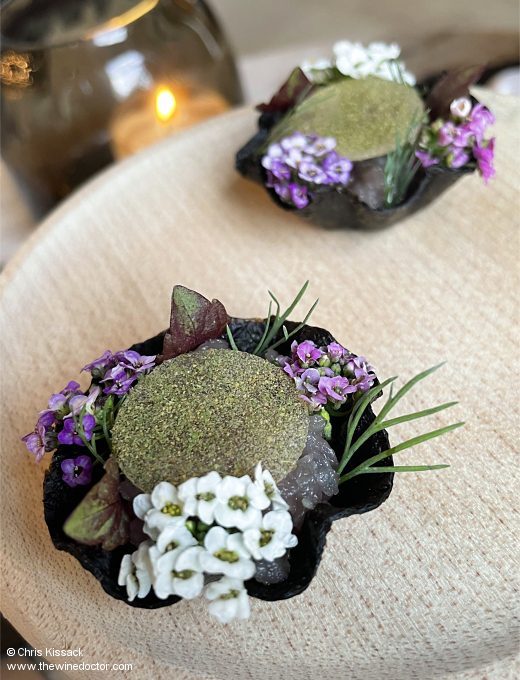
It tastes good too.
And these are just the canapés, nibbled (or messily downed in one in the case of that lobster croustade) and washed along with a glass of the non-vintage L’Extravertie Blanc de Blancs from Pertois-Lebrun. That ten-course tasting menu still awaits us. And for that we must head back downstairs, to the main dining room, via a quick tour of the glass-fronted aging fridges. If your dream dinner begins with a viewing of huge cuts of meat and sides of salmon, patiently waiting for the moment they begin the journey towards your plate, Lyla is the place to come.
The ground floor has been opened up under Stuart’s direction; if memory serves me correctly there was a large window or pass into the 21212 kitchen, as I recall watching Paul plate up, surrounded by a school of adoring sous-chefs who watched every move with the intensity of surgical trainees watching a heart transplant. Under Stuart the wall has gone completely, dining room and kitchen unified as one. The atmosphere in the kitchen feels thankfully less feverish; it seems Stuart Ralston (pictured below, right) has put together a multi-talented and competent team rather than surrounding himself with adoring acolytes.
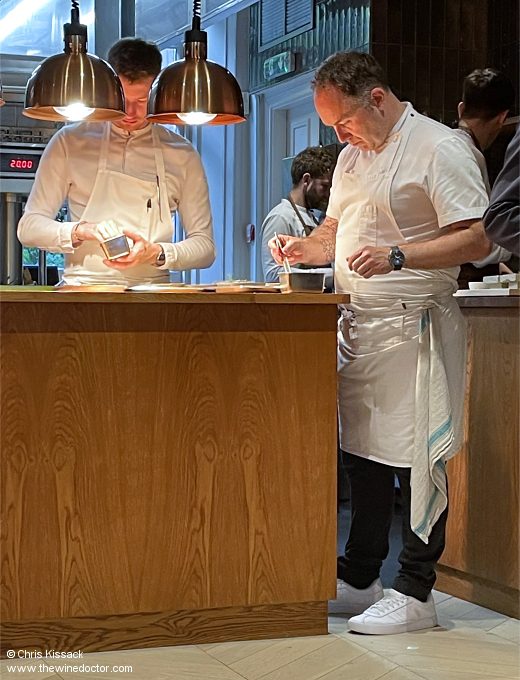
The dining room is warmly lit and dressed with linens, and is close to full. I gratefully take one of the few unoccupied tables, to my good fortune right next to the kitchen.
The menu at Lyla naturally varies with the months and the seasons, but if there is one theme that continues throughout it is seafood and shellfish, from Scotland’s bountiful coastal waters. I am grateful that, when scanning the wine list before heading downstairs, my eye landed on the 2019 Clos de Mosny from Domaine de la Taille aux Loups, as I figured this would work well with just about every dish on the menu.
Thank heavens Lyla actually lists wines I want to drink, rather than a micro-selection of Bordeaux first growths and cult Californian Cabernets. Can you imagine trying to find harmony between finely seared scallops and a glass of Screaming Eagle or similar?
We start with sugar-and-salt cured halibut, dressed with discs of cucumber, daikon radish and sea kelp which has been compressed in blackcurrant juice and lightly dehydrated, topped off with Umai caviar, accompanied by a buttermilk sauce (pictured below). It is a feast for the eyes as well as the palate, a light dish yet one which is packed with mouth-watering umami character from the halibut, caviar and sauce, precisely offset by the freshness of the multi-coloured discs. It is absolutely delicious, and I drain every drop from the dish; I manage to resist the temptation to lift it to my lips and drink what remains, although I am not sure how.
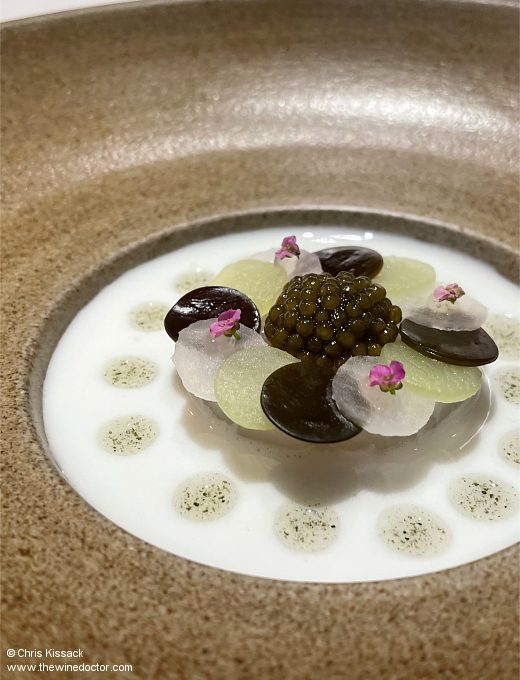
Then comes a dish of langoustine, like no other dish of langoustine I have ever seen. Creel-caught in waters off the west coast of Scotland, just south of Skye, it is the fattest langoustine I have ever had the good fortune of meeting. Or eating. And I have met a lot of langoustines since moving to Scotland.
The langoustine, liberated from its shell, was wrapped in kataifi pastry, essentially shredded filo pastry, before cooking and dusting with dehydrated scallop roe. Served with a burnt apple ketchup which added a tangy freshness to the dish, the inspiration here was a chippy dinner; langoustine for the fish, the burnt apple ketchup for the ‘chippy sauce’, a concoction of brown sauce and vinegar which caused me such confusion the first time I bought a fish supper in Edinburgh (which was in 2004, if you’re interested).
“Don’t worry,” said the waiter with a twinkle in his eye, before he left us to tuck in, “I will come back to sweep up the crumbs.” He knew only too well the explosion that was to come. The kataifi pastry disintegrated into delicious crumbs which flew everywhere. But who cares? This was a remarkable dish. Although inspired by traditional fish ‘n’ chips, this was a world away in terms of, well, everything. Most impressive was the cooking on the langoustine (pictured below), which was sweet and tender, a remarkable achievement considering its heft.

If my local chippy served this I would call in every night.
If you ever ate at Aizle you will know that Asian ingredients and methods are a recurring theme in Stuart’s cooking, and that manifests here in his Chawanmushi course (pictured below). A savoury egg custard renowned in Japanese cuisine, in this case it comes infused with white kombu (from the heart of dried kelp – like the white heart at the centre of a cabbage, I guess), North Sea crab and ginger juice, then dressed with a crab shell bisque. If Stuart Ralston and Lyla has a signature dish, then this is it, and the fact that Stuart himself brought it to our table suggests that he puts more into this particular course than mere ingredients. All I can say about it, having eaten it, is that I now want to get on a plane to Japan, because this was a super one-dish micro-meal which I could eat again and again. I just need to make sure I can get my weekly dose of chippy sauce before I make the move.

Now for bread.
For too many years in British restaurants bread was served as something to be prodded while waiting for the first course to arrive. I never understood this. The French system – baskets of bread topped up with every course, perfect for mopping up those rich sauces – makes much more sense. With the increasing prevalence of tasting menus, however, bread seems to be increasingly moving into a mid-meal position, rightly revered with a dedicated course, a sumptuous star of the show rather than a half-baked warm-up act. It needs to be special though, and Stuart’s laminated brioche roll which came next certainly fit the bill. It comes served with two butters, a cultured wild garlic koji butter and an Oxfordshire butter from the Ampersand dairy. Both were deliciously seasoned and thus readily devoured.
Then it was back to the seafood sequence, continuing with squid (pictured below) cooked sous vide at a modest temperature for 40 minutes, then frozen and sliced to create squid noodles, and dressed with dehydrated tomato, herbs and a tomato consommé infused with katsuobushi, the dried tuna flakes which made my eyes pop with pleasure when they danced in the dish for me at Aizle. Lifted by a little lemon verbena oil, this was another example of why Lyla deserves its strong reputation. It was another umami-laden dish and I made sure every last drop of that consommé found its way onto my spoon and into my mouth. My only regret was that I did not think to hide a little of that brioche roll to finish the mopping up.
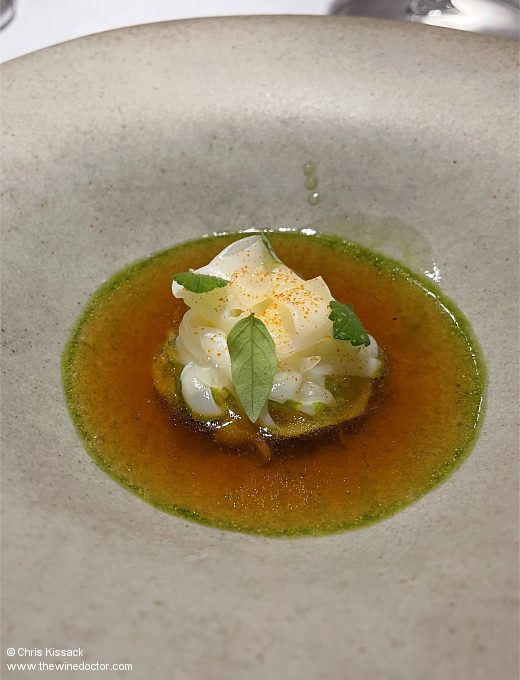
The final seafood dish was a hand-dived scallop, glazed and caramelised, resting on a bed of pickled smoked roe in a vinaigrette, and dressed with N25 Kaluga caviar as well as a hollandaise sauce spiked with slow-roasted tomatoes. Like the langoustine, what really mattered here was the scallop, so large it had been cut in half to provide balance with the rest of the dish, and then perfectly cooked. Combine that with the complementary flavours of caviar and hollandaise, this was another superb combination, even if the volume of smoky, tomato-infused hollandaise added did rather swamp the other flavours and textures.
The seafood done, Stuart transported us back to Japan once more, with a two-pronged dish of Wagyu beef sourced from Kirishima, a coastal region in southern Japan, where (I am told!) the cattle feed on seaweed as well as grass. Part one of this dish (pictured below) features a dinky slice of fillet which is seared on both sides, carved and seasoned with a soy glaze, and served with barbecued maitake mushroom and a healthy portion of black truffles. These truffles have an interesting origin, in that they hail from one of Australia’s leading source of truffles, the Manjimup farm in Western Australia. The truffles are flown in on a regular basis (I guess, with Japanese beef and truffles from Down Under, this is a dish where you should try to banish the guilt over food miles, for a moment at least). This component makes for a strong dish in its own right, although not quite at the level of many of the seafood courses already enjoyed.

I greeted the second part of the dish less eagerly than that sliver of fillet, but it turned out to be one of the most beautifully presented dishes I have ever eaten, and a super example of steak tartare. Dressed in flowers, resting atop a buttery muffin, this was divine. And this comes from someone never readily drawn to steak tartare on a menu.
But just look at it. How could I do anything other than eat, and enjoy?
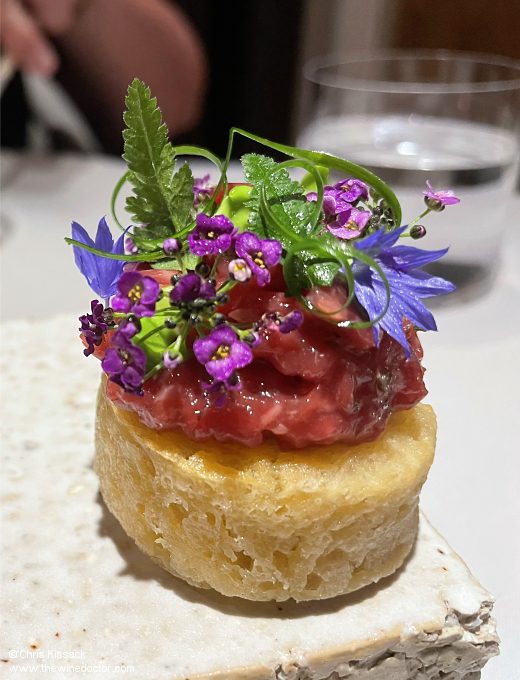
Before the two desserts there came a cheese course, featuring Laganory, which hails from Dumfries and Galloway. While I am always pleased to receive a few slivers of interesting cheeses, the most enjoyable meals I have eaten in the past year or two – including several at Les Jardiniers in Ligré – have been where the chef has used his imagination and talent to create something entirely new. Putting it simply, a cheese dish rather than a selection from the cheese trolley.
This is certainly the approach at Lyla, where the Laganory was gently whipped with a little cream, then covered with fermented raspberry, Madeira and a hibiscus glaze. While visually stunning, I felt the character of the cheese was a little lost within the presentation, but it receives full marks for innovation.
Of the two desserts it was the first which really captured my heart. This was a cultured yoghurt sorbet, served with Amalfi lemon curd, and served with crispy milk skin. No, I did not know what ‘crispy milk skin’ was either. Here Stuart and team take the skin that forms on cooked milk, dehydrate it to create a crisp, and then crumble it into the dish, thus adding texture to the sorbet. It comes dusted with bronze fennel powder, but for me it was the flavour of the lemon which came through strongest, surprisingly so considering the appearance of the dish, which more resembled a fresh snow drift than a dish made with Mediterranean fruit.
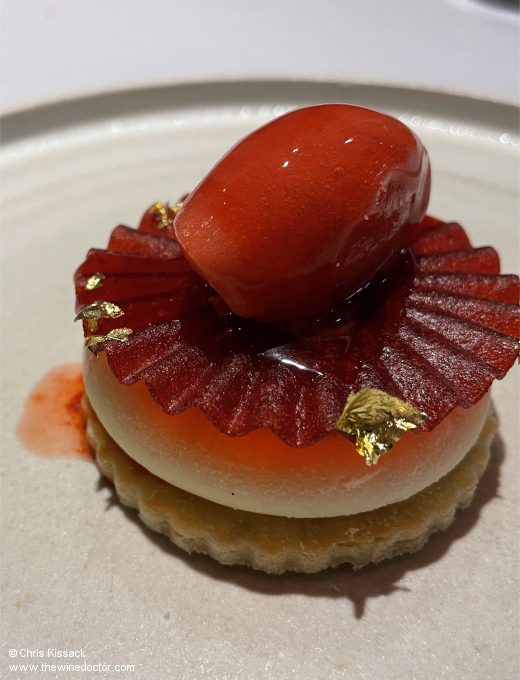
Following this came a strawberry dessert made using fruit from Bruce Farms in Perthshire, served with a crème crue, essentially a cultured cream from Yorkshire, white chocolate, shortbread, lemon zest and dog rose petals, dressed with a little strawberry syrup and rose pickle to balance the richness of the cheesy cream. This was delicious; the lemony composition takes the gold, although I cannot deny this dish had an eye-catching construction (pictured above).
We finished with a selection of petits fours, clearly skilfully made, especially the little ingots of chocolate covered in a blue marbled glaze, but the truth is at this point I could eat no more. The line between experience and ordeal had been crossed, and it is testament to the high quality of each and every dish served that it came only at this late stage.
The dishes that come from Stuart Ralston’s kitchen are impeccably presented, and almost exclusively delicious. There is no doubt that, while it is perhaps a cliché to describe this level of dining experience as art rather than mere food, it is a description that can be appropriately applied to an evening at Lyla. Whether or not this art whispers sweet nothings in your ear, or speaks clearly to your soul, perhaps depends more on the diner than on the chef. All I can say is I heard what Stuart Ralston’s sequence of dishes was saying quite clearly, I liked what I heard, and I would certainly like to return to listen once more.
Please log in to read the tasting notes associated with this dining report: